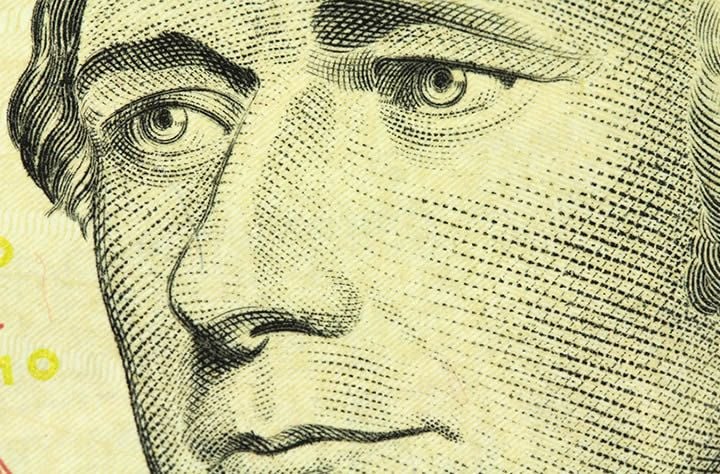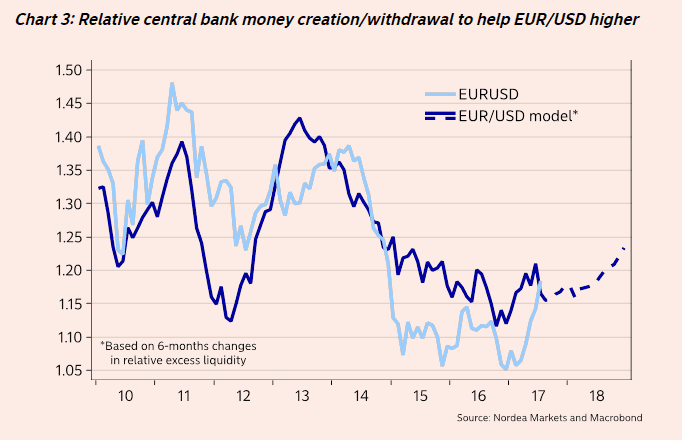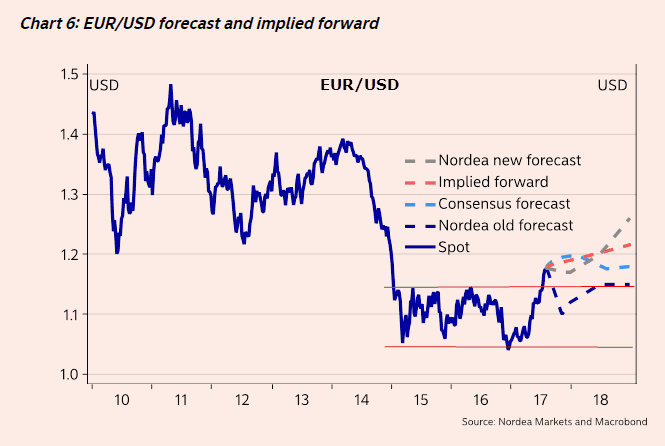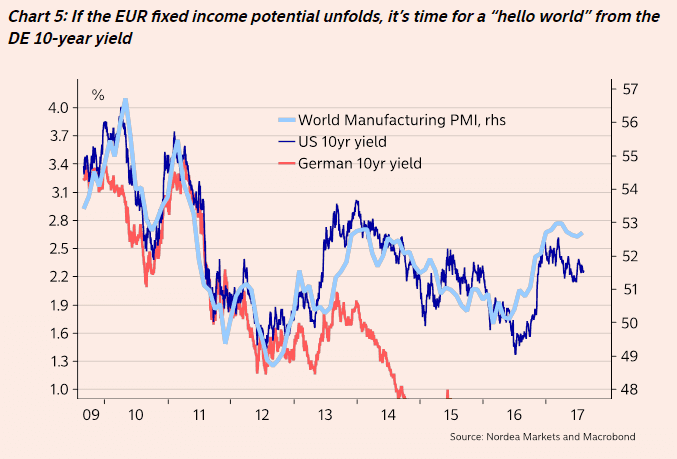"Major" Upgrade to EUR/USD Forecast Announced at Nordea

Nordea Bank have announced "major changes" to a number of key currency forecasts with an upgrade on EUR/USD showing the trend higher we have seen in 2017 will also be a key feature of 2018.
The Euro to Dollar exchange rate is tipped to move higher as the European Central Bank and US Federal Reserve tinker with their policy settings in a manner that favours the Euro over the Dollar.
Both central banks are intending to reduce stimulus which will help to strengthen their currencies, but the reductions to the ECB's moves are tipped to be greater than those at the Fed says Nordea's FX analyst Andreas Steno Larsen.
"Firstly, in our baseline scenario, where the Fed will downscale its balance sheet as outlined at the June meeting and where the ECB will taper its QE programme gradually in the first half of 2018, we expect the relative creation/withdrawal of EURs versus USDs to underpin a higher EUR/USD," says Larsen in a briefing dated August 9.
This, in turn, will lead to a stronger surge in EUR/USD during 2018 than had previously been anticipated.
The upgrade on the Euro by Nordea echoes similar moves made at other financial institutions over recent months; but whether the trend can extend into 2018 remains up for debate. For instance, Rabobank's Jane Foley suggests 1.20 will be a top and an extended period of sideways trading will characterise 2018.
Whether or not the Euro can extend higher depends on the ECB.
The ECB is expected to start reducing its quantitative easing (QE) programme in 2018, by tapering the number of asset purchases it makes each month.
QE involves the central bank buying 'assets', which are soverign bonds mainly, from financial institutions (FI).
The FI's get more money - or liquidity - which they can lend into the real economy to help boost growth, and the central bank gets bonds as a sort of collateral.
Now that the Eurozone is on track in its recovery the ECB feels it can cut back on its QE, gradually reducing the number of purchases from 60bn a month back down to zero.
This gradual tightening in monetary conditions will reduce the number of Euros in the financial system thus increasing the currency's value, and also, as a buyproduct, will increase the yield on Eurozone soverign bonds - further helping the Euro - but we will come to that later.

In contrast the to the ECB, the Fed has stopped active QE but it is still reinvesting the principle it gets back when its bonds mature, using the proceeds to buy new bonds.
Following the financial crisis the Fed undertook massive QE, increasing its balance sheet from 800bn to a whapping 4.5tr today.
At the June 2017 FOMC meeting the Fed announced that it would stop reinvesting the proceeds from its bond stockpile so as to reduce the size of its balance sheet.
By not reinvesting the principle the Fed is undertaking de facto monetary tightening which will reduce the number of Dollar's in the system, and help strengthen the Dollar overall.
According to Larsen it is the 'rate' of monetary tightening which will determine which currency srtrengthens most, and according to his analysis the Euro will come out ontop:
"In other words, the effect from a slower momentum of new EURs in the system will outweigh the effect of the withdrawal of USDs from the financial system," he said.
This has led to Nordea revising up of their forecast for end of 2018 to 1.2600 from a previous 1.1500.

Also factored in is a recovery in Eurozone bond yields, which is expected, and will help support more inflows from investors into the Eurozone, thus further strengthening the Euro.
"Thirdly, if the greater scope for a repricing of European fixed income unfolds (not our baseline scenario), we could also expect renewed tail to the EUR from the FI space. In a full normalization scenario, it will sooner or later be time for a “hello world” for the German 10-year yield in the below chart again – a potential EUR positive to think about," said Larsen.

As for the nearer-term, Larsen is more sanguine, seeing a seasonal reduction in USD liquidity in Q4 2017 as a catalyst keeping the EUR/USD under pressure, andthis informs Nordea's end of 2017 forecast of 1.1700.




